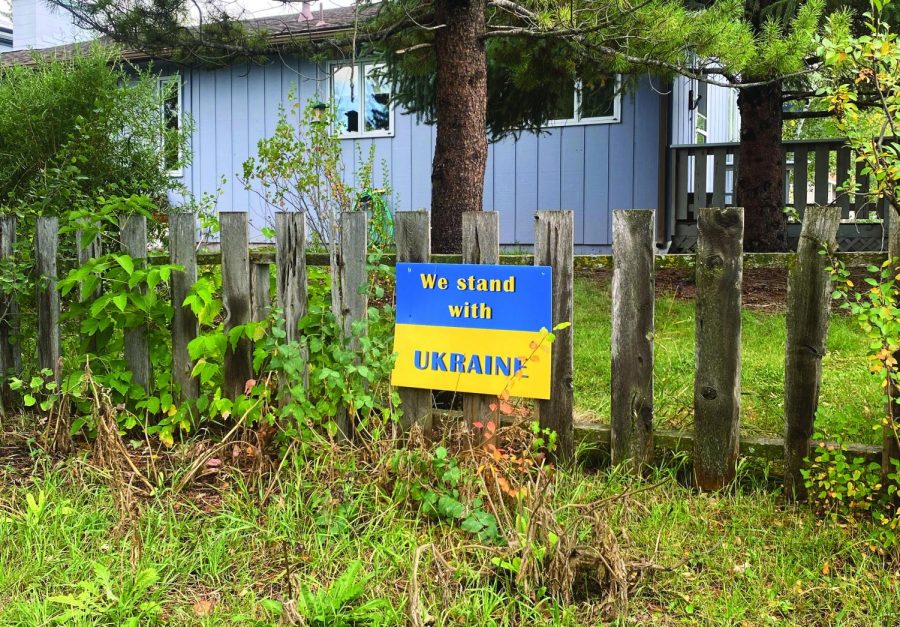The Importance of a Distant War
Rocket bombs sail over the heads of Ukrainian civilians all over Kiev and other major Ukranian cities. Farmers and people living in the Donbas region of Ukraine continue to toil in the fields while the distant sounds of the scattered fighting on the front lines float through the air. While hundreds of Ukrainians are killed every day, life goes on in the rest of the world. Meanwhile, the west continues to sympathize, never understanding the true consequences of what is happening across the world.
Russia began its offensive on Ukraine only 20 years after the fall of the Soviet Bloc and the independence of Ukraine. Russia annexed the Ukrainian region of Crimea in 2014 following a revolution that ousted the current president, Viktor Yanukovych, in favor of a candidate who was pro-Ukrainian independence. Yanukovych’s election incited riots and massive protests later deemed the Orange Revolution. The riots that deposed Yanukovych, the Maidan riots, left more than 100 dead and eventually led to the Russian annexation of Crimea. Not long after Crimea was annexed, Russian separatists began a revolution in the Donbas region, taking over government buildings and declaring independence although it is not recognized. Multiple treaties and cease-fires are signed over the next few years to end violence in the Donbas, but none work.
President Volodymyr Zelenskyy was elected on the 21st of April, 2019, amidst Russian cyber attacks. Soon after conversations with the then US president Donald Trump about a “favor” for an investigation around the Bidens and an energy company called Burisma are reported. America was continuing to send forces into the surrounding countries as diplomatic efforts from the west ramped up exponentially in an attempt to avoid crisis. On February 21, 2022, Russian forces officially entered Ukraine under the guise of a peacekeeping mission in the Donbas, the easternmost region of Ukraine and also a major agricultural region. The invasion begins as Russian rockets and bombs rain down on Ukraine in the WWII; this was the only time since WWII where one European country has seized territory from another.
Hundreds of journalists and news organizations were in Ukraine during the beginning of the war, including world-renowned photojournalist and Washington Post staff photographer, Salwan Georges. A military crisis was already widely expected as Russian forces built up along the border, yet nobody knew when it would come. The day before the war started, life was almost normal in Ukraine; people were still living their lives normally as if their was no threat of war.
“Even the day before the war I was in Kharkiv, and everybody was at shops, restaurants, cafes, living their lives. And then the next day the war started and the country was never the same,” Georges said.
It took very little time for Ukrainian citizens to begin to lose everything to the war. Refugees left their lives behind and traveled west by any means necessary; however, not everyone could leave. Many Ukrainian men joined the army and were headed to the front while their families traveled west, creating powerful scenes at train and bus stations across the country where fathers, husbands, sons, and brothers saw their families off. Ukrainians lost their homes and futures from Russian attacks. In many smaller towns and cities, summary executions, raping, and pillaging are being reported across Russian occupied territory. Russian soldiers went door to door in the village of Staryi Bykiv, rounding up six men who were soon executed on the outskirts of the town.
“She [a mother of one of the victims] told me that the soldiers told her to wait near her house while they took her son to question him. They said the same thing to other families. Instead, they led these six men away, took them to the far end of the village, and shot them,” Human Rights Watch reported on February 27, 2022
However, the losses and problems caused by the war are not only Ukrainian. Ukraine supplies 42% of the worlds sunflower and 16% of the world’s corn, among other major contributions of grains. The UN’s World Food Programme, which feeds refugees and hungry people all over the world, sources 40% of its wheat from Ukraine. Lebanon sources 81% of its wheat imports from Ukraine. The country’s production and exportation of food has slowed dramatically since the start of the war, further amplifying the already devastating food crisis.
Many countries in Europe and around the world have imposed heavy sanctions on Russia and stopped the flow of Russian gas and oil into their country. The EU plans to stop all Russian seaward oil imports by the end of 2022. Additionally, the US is stopping oil and gas imports entirely, and Germany has stopped construction of a major gas pipeline through their territory. All Russian flights have been banned in many countries’ airspaces, including Canada and the US. Not only are these sanctions affecting gas prices and the Russian economy, but major figures and oligarchs in Russia are being sanctioned. Russian assets in foreign banks have been frozen including that of President Putin and Foriegn Minister Sergei Lavrov. The UK froze the assets of all Russian banks.
Financial troubles are not the only problem facing foreign powers, but the possibility of both a nuclear war and disaster looms. Early in August, the Ukrainian Zaporizhzhia Nuclear Plant lost all external power, threatening a nuclear meltdown as a result of a loss for power to cool the fuel in the reactors. Power has since then been restored allowing for a safer possible shutdown. Putin has also threatened nuclear attacks which could lead to an unprecedented disaster. Russia has been using old armaments during their invasion, despite this, when the Russians want to cause serious damage, they do by launching precision strikes on key military and civilian targets. The sporadic actions of the Russian military make it difficult to tell what their next move might be, but the use of the first nuclear weapons in war since Nagasaki could very likely draw other major powers into the war.
Even if some of the war seems out of the control of the average citizen, people around the world can still help Ukranians. Amidst financial donations from the public, weapons and food drives take place around the USA. People can donate through the Ukraine Aid Fund. Even though these donations have helped, with the way the news can be driven by hot topics makes the public lose interest in Ukraine. It is still important to remember Ukraine is a devastating warzone with civilians trapped inside.
“Spreading the news of what’s happening, that’s a way to spread some of the truth. And also looking online, there’s always ways to help,” Georges said.

This is Beau's second year with The Skier Scribbler. He is a junior and is passionate about the environment. He likes to rock climb, ski, and be outside. ...






























